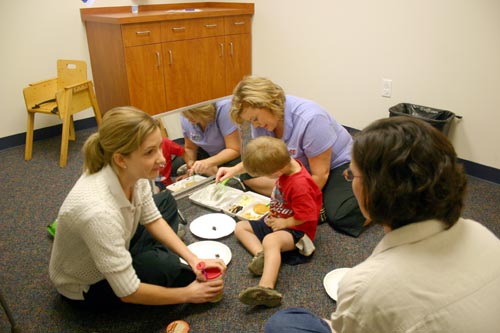|
Nutritional Therapy
is a Collaborative Effort for Ashley Brice
"I have always
been interested in nutrition and healthy eating,"
says Ashley Brice, registered and licensed dietitian
for the J. D. McCarty Center for children with
developmental disabilities in Norman. "Anyone
can claim to be a nutritionist, but I wanted
to know the science behind the nutrition and
healthy eating. That's why I became a medical
nutrition therapist."
Brice's role as medical
nutrition therapist takes her in a lot of directions.
She is responsible for creating a menu for each
patient based on an assessment that takes in
a lot of factors. Brice consults with occupational
and speech-language therapists on feeding issues
as well as with families on specific nutritional
needs for their child.
Medical nutrition therapy
begins with a detailed assessment of the patient.
The assessment begins with a look at the child's
medical history and then moves on to social
and environmental issues. Brice looks at whether
the child is overweight or underweight. She
takes an inventory of the child's diet history
and medication. Knowing the kinds of medications
a child is on is an important factor because
some medications can block the absorption of
nutrients from food. "A child can be a
normal weight, but be nutritionally deficient,"
Brice said.
Finally Brice explores
the cultural, religious and lifestyle factors
in the child's environment that might impact
on their nutrition.
"When I develop a
diet plan for a patient I have to make sure
that it is easy to implement," explains
Brice. "It does no good for the patient
if the family doesn't accept the plan or it's
too difficult for them to implement. I work
very hard to make sure the diet plan will not
only work for the patient, but will fit nicely
into the family environment."
There is more to nutritional
counseling than meal or food planning. Sometimes
she deals with sensory issues like a child not
eating foods of a certain color or texture.
Other times its physical. A child might have
trouble feeding themselves, or have a problem
managing the food in their mouth or have difficulty
in swallowing. "Patients need the right
tools to be successful," said Brice. "That's
the advantage I have in working in a multidisciplinary
setting like the McCarty Center. I have skilled
occupational and speech-language therapists
to consult with when I run into these situations.
Between us we can find
the best way to resolve the barriers a child
might have to getting the most nutrition from
their eating experience."
According to Brice there
is a lot of misinformation about nutrition out
there. Some of it is "old wives tales"
and some of it comes from the information highway
of the Internet. "It's very important for
people to make sure that they get information
from reputable sources like www.eatright.org,
the American Dietetic Association's web site",
Brice said.
Children need to be reassessed
regularly, particularly children with developmental
disabilities because things can change with
them more rapidly. Children that are being tube
fed need to be reassessed every three months
to make sure they're growing properly, that
they're properly hydrated and that any GI track
issues are addressed.
Until recently, the McCarty
Center limited its medical nutrition therapy
services to its inpatients. With the arrival
of Brice the McCarty Center has begun expanding
its medical nutrition services to outpatients
as well. To obtain outpatient nutrition therapy
services a patient needs to have a prescription
from a physician. Once the prescription is obtained
just call the McCarty Center to schedule an
appointment with Brice.
Symptoms that indicate
a child might need to see a nutritionist include
overweight, underweight, failure to thrive,
a child that needs to be tube fed and diabetes
to name a few.
The J. D. McCarty
Center is Oklahoma's center of excellence in
the care and treatment of children with developmental
disabilities from birth to age 21. Founded in
1946, the McCarty Center treated only one diagnosis…cerebral
palsy. Today, the McCarty Center has treated
more than 70 different diagnoses in the developmental
disability category. As the only hospital of
its kind in the state, the McCarty Center will
see, on average, children from 70 of 77 counties
each year.
For more information about the J. D. McCarty
Center visit www.jdmc.org
 |
| Ashley Brice's (left)
approach to nutrition therapy is a one of
collaboration. It involves working with
the patient, parents and other therapists
at the J. D. McCarty Center to achieve the
results she wants for her patient. Brice
is shown here talking with Mandy Latham
(right) about the progress her son Samuel
has been making while speech-language pathologist
Chrissy Hancock introduces Samuel Latham
to some new food textures. |
|